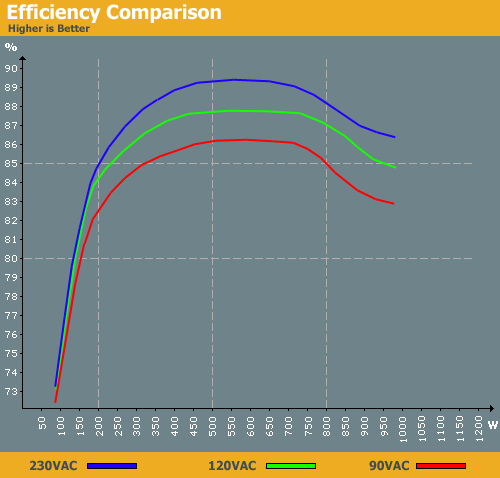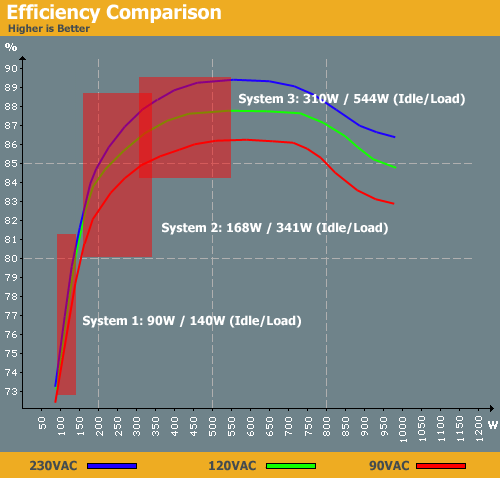Debunking Power Supply Myths
by Christoph Katzer on September 22, 2008 3:00 AM EST- Posted in
- Cases/Cooling/PSUs
Efficiency Explained
All power supplies have a specific efficiency curve, which we show in our reviews. As an example, we will use the Cooler Master UCP 900W power supply. Here is the efficiency curve we measured during testing:

Efficiency is the output power divided by the input power, as there is a certain amount of power lost during the AC to DC conversion. The x-axis shows the power supply load in Watts and the y-axis shows efficiency. Let's include our three sample systems in the chart see what sort of efficiency they would get with this power supply.

The first system causes this high-performance power supply to only run at 73% to 81% efficiency, depending on input voltage. Obviously, there's absolutely no need for a 900W power supply if you're running this type of computer.
The midrange system looks quite a bit better, allowing the PSU to run at 80% to 88% efficiency, although the latter only occurs at maximum load. Considering the vast majority of systems rarely run at 100% load most of the time, real-world efficiency will average closer to 82%. Office work and Internet surfing in particular will be at that level.
For the third system, a 900W power supply actually might start to make sense. It's still more than you need, but having a bit of extra room to grow isn't a bad idea. This system idles at over 300W, so it achieves a minimum 86% efficiency with 120VAC. When running a game or other demanding task, the PSU is finally able to reach its potential and provide 89% efficiency with 230VAC (or 87.5% with 120VAC).
The quick summary then is that if you don't have a system that uses 350W of power when idle, it's probably not worthwhile to purchase this type of power supply. Our high-end sample system more or less meets this qualification, and if you were to take such a system and overclock it, these high-end power supplies are actually required. The 8800 Ultra is one of the most demanding graphics cards currently available; however, the GTX 280 appears to require even more power, making that another candidate for this sort of PSU. (Unfortunately, our power supply testing labs didn't have the latest GPUs available for testing.)










98 Comments
View All Comments
computerfarmer - Tuesday, September 23, 2008 - link
Good article! Based on the number of comments, this has many of us thinking. This gives a way of figuring out our needs vs bigger is better.This article gives us enough information to make educated choices. Looking at the 12V rails is a good place to start along with total power. With a single 12V rail like Corsair VX series, the amount each rail carries is a non issue.
A rule I have always followed is to use a power supply with at least 20% more power than the maximum required.
dragosmp - Tuesday, September 23, 2008 - link
Hey, I just wanted to say that after posting this link on OCN, there were tenths of replies. People want to know how much various things consume, as all this 1kW PSU hype hype is getting very tiresome.I for one would be curious how did you measure the current thru the PCIe slot - have you modified the slot to access the power lines? Soldering geeks would really like to know :)
And lastly, browser compatibility. This comment is very hard to write in Chrome (writing overlapping), maybe you or google will fix this.
Cheers,
Dragosmp
Fudus - Tuesday, September 23, 2008 - link
I am stupid and run my 4850 off a 300W power supply, with a sata power>molex>pci-E power connection. Go Go overloading!It seems to work at stock speeds under stress as well for some reason. I really didn't expect it to work this well (C2D e6550, Radeon 4850,300W power supply, 2GB RAm, G33 motherboard, 1 HD/DVD+RW)
marc1000 - Tuesday, September 23, 2008 - link
you are not stupid, Fudus. if you sum the power for your c2d (never more than 65w), mobo (40w), ram+HD+DVD (5+15+10) you have 135w. then add the 4850 and you are still fine with a 300w PSU. Like i Said before, I have a 90W CPU (that old Pentium-D, argh!) but run a radeon 3850, so my system consumes about the same energy as yours. and the 300w is working fine with me too. or else I would be a stupid too =Pdragosmp - Tuesday, September 23, 2008 - link
Wow, this gives me hopes to mount a 4670 on a 120W pico-atx powered rig.How is the noise, the +12V level?
oopyseohs - Monday, September 22, 2008 - link
I have seen upwards of 700W while testing on old QuadFX systems with 8800Ultra SLI. I would imagine that Skulltrail overclocked to 4.0GHz (easy) and 2x Radeon HD4870X2's in CrossFireX would demand significantly more than 700W. Of course these systems are rare, but they do technically validate the "need" for power supplies that output 1000W+.In any case, thanks for this article. I think it does a great job of showing why ultra high-output power supplies are not even close to necessary for 99.9% of the computing world.
JarredWalton - Monday, September 22, 2008 - link
I have a Q6600 @ 3.42GHz with dual 3870 cards, and that peaks at around 650W at the outlet. Certainly there are plenty of overclocked PCs that can draw more than 700W... but once you take efficiency into account, my PC is only really using around 520W. I've also tested high-end water-cooled setups with 8800 GTX SLI that topped out at 650-700W power draw as well. I personally think with ultra high-end PSUs that having six 12V rails isn't very useful as well - some of the problems people experience with lesser PSUs simply comes from 12V rail distribution.If you're running dual GTX 280 cards and a quad-core (probably overclocked) CPU, I don't think there's anything wrong with 1000W PSUs. In fact, I know Gary has blown a few 1000W PSUs with his overclocking testing in the past. However, I'm running perfectly happy now with a 3.2GHz quad-core and really don't need even that much CPU performance; it's all about the GPU for games, and CPUs are only really taxed in 3D rendering and video encoding it seems.
Griswold - Monday, September 22, 2008 - link
Now that you made that clear, give us some of your great reviews for reasonably dimensioned PSUs instead of these 600-1000W bricks. :Pwhatthehey - Monday, September 22, 2008 - link
Maybe it's just me, but I sort of got the impression that the reason for this article is precisely that Anandtech is tired of only getting the highest-end power supplies for testing. It's all marketing BS of course: they don't want to limit sales of the $300 1000W PSUs so they only send those out for testing.Or maybe the truth is more nefarious: they figure if they send out a top-quality 1000W PSU that has great efficiency and voltage regulation, unsuspecting buyers will buy their lower wattage parts that might not be all that great? The first is more likely, but it wouldn't surprise me if some of the less expensive 400-500W PSUs (even from major brands) use much cheaper components. Which is why we all want to see them tested, and probably also why the companies don't want to send them out for review.
Martimus - Monday, September 22, 2008 - link
Since this article is about choosing a PSU for a new computer build, it would have been nice to include new components like the P45 chipset, or the new nVidia or AMD graphics cards. I started reading it with the hope of knowing how well the Antec Earthwatts 500W PSU that came with the Sonata III case I bought would be do with various build options. The problem was that with only old equipment being used, I couldn't come to any real conclusion. It seemed to read more like a report to prove a point rather than an actual guide written to help with a new computer build. I am not trying to berate the article, but I just don't see the point of it.